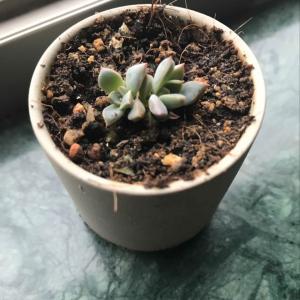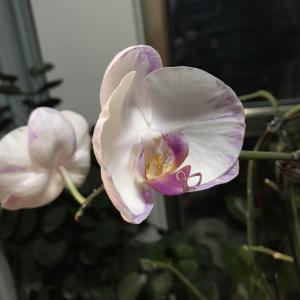文章
Dummer. ゛☀
2017年09月23日

Portulacaria afra, (known as Elephant Bush) is a perennial succulent native to South Africa. It thrives in Sunset Climate Zones 8 through 9 and 12 through 24. This plant reaches heights of 3 feet (90 cm) with a spread of 4 feet (1.2 m) and adapts to either full sun or shade. Elephant Bush also adapts to a range of soil and is not particular about the pH, but does require well-drained soil.
1. Cut a 4- to 6-inches (10- to 15-cm) cutting from the growing tip of your Elephant Bush with a clean sterilized razor blade. Pruning shears or scissors can bruise the stem causing delayed healing.
2. Remove the bottom leaves from the stem cutting, leaving a 2- to 4-inches (5- to 10-cm) section of the stem bare.
3. Dip the bottom 2 inches (5 cm) of the stem of your Elephant Bush cutting in rooting compound. Tap the stem against the container to remove excess powder. Many prefer to pour the rooting powder into a paper cup and then dispose of the excess powder and cup together. This prevents contaminating the container of rooting powder.
4. Place the cutting in a warm well-ventilated area to heal and form a callous. Healing time varies, but typically ranges from a few days to a week for Elephant Bush.
5. Mix four parts sand or perlite with one part potting soil and fill a 4-inch (10-cm) pot with the mixture. Firm the soil down with your hands to level the surface. This creates soil that drains well and provides good aeration for your cuttings.
6. Insert the stem of your Elephant Bush into the mixture to a depth of 2 inches (5 cm). Firm the soil around the stem of your cutting with your hands to secure it in the soil.
7. Add a 1/4- to 1/2-inch (0.6- to 1.2-cm) layer of gravel over the top of the pot to conserve water and prevent soil from spilling over the edges when watering.
8. Water to moisten the soil. Although Elephant Bush does not typically require frequent watering, it needs even moisture for young roots to grow.
9. Place your cutting in a sunny, warm, well-ventilated area. Move your Elephant Bush to its permanent location once roots have formed and the plant shows new growth.

1. Cut a 4- to 6-inches (10- to 15-cm) cutting from the growing tip of your Elephant Bush with a clean sterilized razor blade. Pruning shears or scissors can bruise the stem causing delayed healing.
2. Remove the bottom leaves from the stem cutting, leaving a 2- to 4-inches (5- to 10-cm) section of the stem bare.

3. Dip the bottom 2 inches (5 cm) of the stem of your Elephant Bush cutting in rooting compound. Tap the stem against the container to remove excess powder. Many prefer to pour the rooting powder into a paper cup and then dispose of the excess powder and cup together. This prevents contaminating the container of rooting powder.
4. Place the cutting in a warm well-ventilated area to heal and form a callous. Healing time varies, but typically ranges from a few days to a week for Elephant Bush.

5. Mix four parts sand or perlite with one part potting soil and fill a 4-inch (10-cm) pot with the mixture. Firm the soil down with your hands to level the surface. This creates soil that drains well and provides good aeration for your cuttings.
6. Insert the stem of your Elephant Bush into the mixture to a depth of 2 inches (5 cm). Firm the soil around the stem of your cutting with your hands to secure it in the soil.

7. Add a 1/4- to 1/2-inch (0.6- to 1.2-cm) layer of gravel over the top of the pot to conserve water and prevent soil from spilling over the edges when watering.
8. Water to moisten the soil. Although Elephant Bush does not typically require frequent watering, it needs even moisture for young roots to grow.

9. Place your cutting in a sunny, warm, well-ventilated area. Move your Elephant Bush to its permanent location once roots have formed and the plant shows new growth.
1
2
文章
Dummer. ゛☀
2017年09月23日

Echinocactus grusonii, better known as Golden Barrel Cactus, gets its common name from its barrel-like shape. It typically reaches 12 to 24 inches (30 to 60 cm) in diameter and up to 36 inches (90 cm) in height.
You can sow Golden Barrel Cactus seeds outdoors in warm climates, but sowing them indoors is easier and will result in a higher germination rate. Expect the seeds to germinate in one to two months.
1. Soak Golden Barrel Cactus seeds overnight in room-temperature water. Soaking seeds will help increase germination rates.
2. Fill a seed tray three-fourths of the way with slightly moist potting medium made with 1 part sand and 1 part high-quality potting soil.
3. Scatter two or three seeds per seed compartment on top of the soil. Then, cover the seeds lightly with a thin layer of sand.
4. Slip the seed tray into a plastic bag and tie it closed with a twist tie. Place the tray in a bright area, but out of direct sunlight, that is between 70 and 80 degrees Fahrenheit (21 and 27 degrees Celsius).
5. Keep the soil slightly moist until germination. Spraying the soil with a mister or spray bottle, rather than watering it from the top, will help prevent the soil and seeds from becoming too wet. After the seedlings emerge, you can take off the bag and set the tray into a sunny area until they are several inches tall and large enough to transplant to a larger container.

You can sow Golden Barrel Cactus seeds outdoors in warm climates, but sowing them indoors is easier and will result in a higher germination rate. Expect the seeds to germinate in one to two months.

1. Soak Golden Barrel Cactus seeds overnight in room-temperature water. Soaking seeds will help increase germination rates.
2. Fill a seed tray three-fourths of the way with slightly moist potting medium made with 1 part sand and 1 part high-quality potting soil.
3. Scatter two or three seeds per seed compartment on top of the soil. Then, cover the seeds lightly with a thin layer of sand.

4. Slip the seed tray into a plastic bag and tie it closed with a twist tie. Place the tray in a bright area, but out of direct sunlight, that is between 70 and 80 degrees Fahrenheit (21 and 27 degrees Celsius).

5. Keep the soil slightly moist until germination. Spraying the soil with a mister or spray bottle, rather than watering it from the top, will help prevent the soil and seeds from becoming too wet. After the seedlings emerge, you can take off the bag and set the tray into a sunny area until they are several inches tall and large enough to transplant to a larger container.
1
1
文章
Dummer. ゛☀
2017年09月23日

Kalanchoe is a succulent plant valued for its vivid, bright colors, and tightly clustered bouquets of little flowers. It’s hardy in USDA zones 10 through 12, but makes an excellent indoor plant. Kalanchoe flowers can start losing their vibrancy in the second and third years of growth, but propagation methods are easy and can produce young, healthy varieties that grow from 36 to 48 inches (90 to 120 cm). The seeds from cross-pollination can produce some interesting hybrids as well, but there’s no guarantee that there will be a particular resemblance to the parent plants. If you want to give it a try and see what you get, seed propagation is right for you. If you would rather have more of the same plant, you can propagate Kalanchoe plants by using cuttings.
Seeds
Kalanchoe seeds are tiny, around 2.5 million per ounce. When you propagate Kalanchoe with seeds, you’ve got two options. The first is to purchase seeds from your local garden center or nursery. The second is to cross-pollinate two Kalanchoe or more in your perennial flower garden if you have them. You can crossbreed the two varieties and come up with a hybrid that can either have traits of the parent plants, traits of its own, or both. It’s always exciting to see what crossbreeding two Kalanchoe plants will bring you, and what colors you’ll see in your shrub.
To crossbreed, wait until you have two or more plants in full bloom. Use a small paintbrush or Q-tip to brush pollen from the stamen of one flower to the stigma of another, transferring from plant to plant. Since the flowers come in crowded bundles, it may be easiest to cut off a clump of them and pull them apart to get to the pollen.
The Kalanchoe seeds can go directly into warm, slightly moist soil made of half cactus mix and half fine potting soil. The warmth and the humidity of the dirt will activate the seed’s growth hormones and guide the sprout towards nutrients, thus giving you a baby Kalanchoe sprout.
Seeds should be placed in indirect light and kept at temperatures between 70 and 75 degrees Fahrenheit (21 and 24 degrees Celsius). Fill a clean spray bottle with filtered or rain water and mist the seeds only when the soil appears dry. Do not over water! Germination should take around 10 days. Pinch the seedling back lightly at six to eight weeks. When they are 6 inches (15 cm) high, transplant the seedlings to their own individual 1 to 2-inch (2.5 to 5 cm) pots and follow the care instructions below.
Leaf Cuttings
If you want to have the exact same plant in repetition in your garden, you can propagate Kalanchoe with leaf cuttings. Take your cuttings in early spring, using a pair of sharp garden shears to cut a few strong green shoots off of the Kalanchoe, 6 to 9 inches (15 to 22.5 cm) long. Strip the leaves off of the bottom 3 inches (7.5 cm) of the cutting. You should allow the cuttings to dry on the counter for around three days to let the cut side heal up. If you plant the cutting immediately, it will be susceptible to rot.
The soil requirement for cutting propagation is a cactus mix blended with some humus topsoil. Before planting, water the mix thoroughly and allow it to drain for half an hour so that the soil is moist for planting. Dig a small hole and stand the cutting upright, filling the hole in and pressing firmly so that it stands up on its own.
Avoid watering the Kalanchoe cutting for at least one week. This encourages the leaf to survive in rather dry conditions by rooting through the soil. The dirt you use should be permeable, well-drained and never overwatered. You should attempt to propagate multiple cuttings to achieve at least one viable seedling. Small plants will begin to grow from the base of the cutting after one month. Keep the seedlings moist, spraying them with filtered or rain water, but never letting it puddle.
Seedling Care
After a month or two gently dig the little Kalanchoe plants from their potting mix and transplant them into individual 1 or 2-inch (2.5 or 5 cm) pots. Fill the pots with a mix of coarse sand, peat moss, and compost. Always put an inch of pebbles or broken pottery in the bottom of the pot to improve drainage. They can now be treated like mature plants.
Kalanchoe need temperatures of between 60 and 85 degrees Fahrenheit (15 and 30 degrees Celsius) to thrive, and repeated exposure to colder temperatures will kill it. Keep your indoor Kalanchoe away from doors or drafts during the winter and consider using a radiator or small heating pad set on low to maintain these temperatures.
Kalanchoe love sun, but avoid direct sunlight in the summer when it can scald them. These environmental parameters should be used until transplantation. Your plants generally won’t be ready for a permanent home in your garden until they’re about two or three years old. They need to be between the adolescent and mature stage so that transplanting doesn’t shock the plant to death. If you do not live in UDSA hardiness zones 10 through 12, you have to keep your Kalanchoe as a houseplant permanently. Allow the soil to become dry between watering to avoid root rot, a common problem.
Whichever way you choose to propagate your Kalanchoe, you can reap all of the benefits of this low-maintenance plant. You can re-bloom it, you can gift adolescent plants to someone else to care for, and you can even forget to water them sometimes—they’ll forgive you, and they’ll even reward you with more blooms.

Seeds
Kalanchoe seeds are tiny, around 2.5 million per ounce. When you propagate Kalanchoe with seeds, you’ve got two options. The first is to purchase seeds from your local garden center or nursery. The second is to cross-pollinate two Kalanchoe or more in your perennial flower garden if you have them. You can crossbreed the two varieties and come up with a hybrid that can either have traits of the parent plants, traits of its own, or both. It’s always exciting to see what crossbreeding two Kalanchoe plants will bring you, and what colors you’ll see in your shrub.

To crossbreed, wait until you have two or more plants in full bloom. Use a small paintbrush or Q-tip to brush pollen from the stamen of one flower to the stigma of another, transferring from plant to plant. Since the flowers come in crowded bundles, it may be easiest to cut off a clump of them and pull them apart to get to the pollen.
The Kalanchoe seeds can go directly into warm, slightly moist soil made of half cactus mix and half fine potting soil. The warmth and the humidity of the dirt will activate the seed’s growth hormones and guide the sprout towards nutrients, thus giving you a baby Kalanchoe sprout.

Seeds should be placed in indirect light and kept at temperatures between 70 and 75 degrees Fahrenheit (21 and 24 degrees Celsius). Fill a clean spray bottle with filtered or rain water and mist the seeds only when the soil appears dry. Do not over water! Germination should take around 10 days. Pinch the seedling back lightly at six to eight weeks. When they are 6 inches (15 cm) high, transplant the seedlings to their own individual 1 to 2-inch (2.5 to 5 cm) pots and follow the care instructions below.

Leaf Cuttings
If you want to have the exact same plant in repetition in your garden, you can propagate Kalanchoe with leaf cuttings. Take your cuttings in early spring, using a pair of sharp garden shears to cut a few strong green shoots off of the Kalanchoe, 6 to 9 inches (15 to 22.5 cm) long. Strip the leaves off of the bottom 3 inches (7.5 cm) of the cutting. You should allow the cuttings to dry on the counter for around three days to let the cut side heal up. If you plant the cutting immediately, it will be susceptible to rot.

The soil requirement for cutting propagation is a cactus mix blended with some humus topsoil. Before planting, water the mix thoroughly and allow it to drain for half an hour so that the soil is moist for planting. Dig a small hole and stand the cutting upright, filling the hole in and pressing firmly so that it stands up on its own.

Avoid watering the Kalanchoe cutting for at least one week. This encourages the leaf to survive in rather dry conditions by rooting through the soil. The dirt you use should be permeable, well-drained and never overwatered. You should attempt to propagate multiple cuttings to achieve at least one viable seedling. Small plants will begin to grow from the base of the cutting after one month. Keep the seedlings moist, spraying them with filtered or rain water, but never letting it puddle.

Seedling Care
After a month or two gently dig the little Kalanchoe plants from their potting mix and transplant them into individual 1 or 2-inch (2.5 or 5 cm) pots. Fill the pots with a mix of coarse sand, peat moss, and compost. Always put an inch of pebbles or broken pottery in the bottom of the pot to improve drainage. They can now be treated like mature plants.

Kalanchoe need temperatures of between 60 and 85 degrees Fahrenheit (15 and 30 degrees Celsius) to thrive, and repeated exposure to colder temperatures will kill it. Keep your indoor Kalanchoe away from doors or drafts during the winter and consider using a radiator or small heating pad set on low to maintain these temperatures.

Kalanchoe love sun, but avoid direct sunlight in the summer when it can scald them. These environmental parameters should be used until transplantation. Your plants generally won’t be ready for a permanent home in your garden until they’re about two or three years old. They need to be between the adolescent and mature stage so that transplanting doesn’t shock the plant to death. If you do not live in UDSA hardiness zones 10 through 12, you have to keep your Kalanchoe as a houseplant permanently. Allow the soil to become dry between watering to avoid root rot, a common problem.

Whichever way you choose to propagate your Kalanchoe, you can reap all of the benefits of this low-maintenance plant. You can re-bloom it, you can gift adolescent plants to someone else to care for, and you can even forget to water them sometimes—they’ll forgive you, and they’ll even reward you with more blooms.
1
0
文章
Dummer. ゛☀
2017年09月22日

Aloe aristata, also known as Lace Aloe, is a small hardy succulent plant popular as an indoor plant. It is a stemless, up to 12 inches (30 cm) tall, clump-forming succulent with dense rosettes of stubby, lance-shaped, toothed, white-margined, dark green leaves, up to 4 inches (10 cm) long, with small white spots and soft white spines, particularly beneath. In the fall, produces terminal panicles, up to 20 inches (50 cm) tall, 2 to 6 branched, bearing cylindrical, orange-red flowers, up to 1.5 inches (4 cm) long.
Growing Conditions
Light: Bright light suits Aloe aristata. It will not thrive if permanently placed at a distance from a window.
Soil: Dry and well drained gritty soils are suitable for these plants. Sandy free draining soil will keep the Aloe aristata healthy. Use cactus compost or add sand to improve the garden soil drainage.
Temperature: Aloe aristata plants grow well in normal room temperatures and are tolerant of dry air. To encourage flowering, however, it is best to give the plants a short winter rest at a temperature of no more that 50°F (10°C).
Watering: During the active growth period water plentifully as often as necessary to keep the potting mixture thoroughly moist. During the rest period water only enough to prevent the potting mixture from drying out. Do not permit water to collect in the tight rosette.
Fertilizing: Feed Aloe aristata very little now and then during the active growth period.
Potting and Repotting
Use a soil based potting mixture. Most Aloe aristata should be moved into pots one size larger every spring. Keep these plants in shallow pots. When maximum convenient pot size has been reached, plants should be top dressed with fresh potting mixture once a year. To prevent rot, make sure that these plants which have tick basal leaves are never buried deeper than they were before. A sprinkling of coarse sand over the surface of the potting mixture helps to prevent rot points where fleshy leaves of these stemless plants touch the soil.
General Care
In order to grow Aloe aristata in temperate climates they will need to be taken inside during the coldest weather and keep them in bright sunlight during the summer. This species is hardier than many other species within its genus, but will still appreciate the warmth. It requires very little maintenance, making it an ideal choice for novice gardeners. They flower freely in the summer and the soft-orange flowers are a wonderful addition to the arid garden. This genus is well known for its ease of cultivation, but they are sensitive to excessive irrigation. Provide regular watering in spring and summer to make the soil thoroughly moist then allow the soil to dry before watering again. In winter (during the dormant season) water sparingly or not at all, as it is prone to rotting; a thin layer of gravel on top of the soil will help to prevent this.
Propagation
Aloe aristata produces offsets that can be taken from the base of a plant early in summer. These small new rosettes are often attached to the parent by a short underground stolon and may already have little roots, which should be retained for propagation propose. Because very tiny offsets are hard to root, they should not be removed for planting until their leaves have begun to open into the characteristic rosette shape. Offsets will root in two to three weeks in the standard potting mixture if some coarse sand is sprinkled at the base of the rosette to prevent rotting. Until offsets are well established, they should be provided with bright light without direct sunlight and they should be watered only enough to moisten the potting mixture, allowing the top two-thirds of the potting mixture to dry out between waterings.
Also, Aloe aristata can be propagated by seed sown in warm environment as soon as ripe.
Pests and Problems
Most likely to be caused by incorrect watering. A properly watered Aloe aristata plant can resist most pests and diseases. Wilting is the result of inadequate water in summer. Yellowing leaves accompanied by rotting at the base is the result of overwatering plants kept in cool winter conditions.
Mealy bugs and root mealy bugs ca be troublesome. The former hide deep in the crevices of rosette foliage and the latter generally bury themselves in the roots, just below the surface of the potting mixture.
Treatment: Remove visible bugs with a toothpick or a damp cloth or swab them off foliage with a small, stiff paintbrush dipped in methylated spirit or an insecticide solution. Then spray all top growth with an appropriate pesticide. Alternatively, place granules of a systemic pesticide in the potting mixture. During the next month examine plants weekly for traces of reinfestation.
Scale insects can also infest this plant.
Treatment: Scale can be easily controlled by physical removal, wash off with high pressure jet of water or scrape off with cotton wool buds or by chemical control with appropriate pesticide.

Growing Conditions
Light: Bright light suits Aloe aristata. It will not thrive if permanently placed at a distance from a window.
Soil: Dry and well drained gritty soils are suitable for these plants. Sandy free draining soil will keep the Aloe aristata healthy. Use cactus compost or add sand to improve the garden soil drainage.

Temperature: Aloe aristata plants grow well in normal room temperatures and are tolerant of dry air. To encourage flowering, however, it is best to give the plants a short winter rest at a temperature of no more that 50°F (10°C).
Watering: During the active growth period water plentifully as often as necessary to keep the potting mixture thoroughly moist. During the rest period water only enough to prevent the potting mixture from drying out. Do not permit water to collect in the tight rosette.
Fertilizing: Feed Aloe aristata very little now and then during the active growth period.

Potting and Repotting
Use a soil based potting mixture. Most Aloe aristata should be moved into pots one size larger every spring. Keep these plants in shallow pots. When maximum convenient pot size has been reached, plants should be top dressed with fresh potting mixture once a year. To prevent rot, make sure that these plants which have tick basal leaves are never buried deeper than they were before. A sprinkling of coarse sand over the surface of the potting mixture helps to prevent rot points where fleshy leaves of these stemless plants touch the soil.

General Care
In order to grow Aloe aristata in temperate climates they will need to be taken inside during the coldest weather and keep them in bright sunlight during the summer. This species is hardier than many other species within its genus, but will still appreciate the warmth. It requires very little maintenance, making it an ideal choice for novice gardeners. They flower freely in the summer and the soft-orange flowers are a wonderful addition to the arid garden. This genus is well known for its ease of cultivation, but they are sensitive to excessive irrigation. Provide regular watering in spring and summer to make the soil thoroughly moist then allow the soil to dry before watering again. In winter (during the dormant season) water sparingly or not at all, as it is prone to rotting; a thin layer of gravel on top of the soil will help to prevent this.

Propagation
Aloe aristata produces offsets that can be taken from the base of a plant early in summer. These small new rosettes are often attached to the parent by a short underground stolon and may already have little roots, which should be retained for propagation propose. Because very tiny offsets are hard to root, they should not be removed for planting until their leaves have begun to open into the characteristic rosette shape. Offsets will root in two to three weeks in the standard potting mixture if some coarse sand is sprinkled at the base of the rosette to prevent rotting. Until offsets are well established, they should be provided with bright light without direct sunlight and they should be watered only enough to moisten the potting mixture, allowing the top two-thirds of the potting mixture to dry out between waterings.

Also, Aloe aristata can be propagated by seed sown in warm environment as soon as ripe.
Pests and Problems
Most likely to be caused by incorrect watering. A properly watered Aloe aristata plant can resist most pests and diseases. Wilting is the result of inadequate water in summer. Yellowing leaves accompanied by rotting at the base is the result of overwatering plants kept in cool winter conditions.

Mealy bugs and root mealy bugs ca be troublesome. The former hide deep in the crevices of rosette foliage and the latter generally bury themselves in the roots, just below the surface of the potting mixture.
Treatment: Remove visible bugs with a toothpick or a damp cloth or swab them off foliage with a small, stiff paintbrush dipped in methylated spirit or an insecticide solution. Then spray all top growth with an appropriate pesticide. Alternatively, place granules of a systemic pesticide in the potting mixture. During the next month examine plants weekly for traces of reinfestation.

Scale insects can also infest this plant.
Treatment: Scale can be easily controlled by physical removal, wash off with high pressure jet of water or scrape off with cotton wool buds or by chemical control with appropriate pesticide.
0
0
文章
Miss Chen
2017年09月21日

La escaevola o flor de abanico, Scaevola aemula, es una planta originaria de Australia. Pertenece a la familia de las Goodeniaceae que está compuesta por 12 géneros y unas 410 especies. La mayoría de éstas crecen también en Australia excepto el género Scaevola que lo hace en diversas áreas tropicales del mundo.
Las especies de esta familia se caracterizan por ser arbustos o subarbustos con hojas simples, carnosas, dispuestas de forma alterna y sin estípulas. Las plantas de la familia Goodeniaceae son angiospermas y tienen las flores bisexuales agrupadas en inflorescencias axilares presentadas en dicasios. Los frutos de esta familia son drupas carnosas.

El abanico, como también se conoce a la planta, no alcanza mucha altura y tiene un crecimiento rastrero lo que lo hace ideal como cubresuelo o planta tapizante. Su altura suele estar entre 25 y 40 cm y en cambio alcanza los 70 cm de envergadura. Se trata además de una planta perenne que nos va a durar bastante tiempo. La escaevola florece en primavera y verano con sus curiosas flores parecidas a las margaritas pero con sólo cinco pétalos agrupados en un lado como si fuera una mano.

Se puede cultivar fácilmente en lugares con climas templados, cálidos y tropicales. Si queremos cultivarlo en una zona de clima frío habrá que protegerla del invierno colocándola dentro de casa o en un invernadero durante esta estación. La escaevola se cultiva tanto a pleno sol como en sombra parcial pero siempre en ambientes muy luminosos. El mejor suelo para su cultivo es el arenoso y si es rico en materia orgánica mucho mejor. Necesita ante todo un buen drenaje pues sus raíces son muy sensibles al exceso de humedad.

Hay distintas variedades de escaevola con flores en diferentes colores, azul, lila y blanco. Se usa en rocallas y como planta tapizante para lugares sin tránsito, bajo los árboles por ejemplo. Se puede reproducir por semillas y por esquejes.
Las especies de esta familia se caracterizan por ser arbustos o subarbustos con hojas simples, carnosas, dispuestas de forma alterna y sin estípulas. Las plantas de la familia Goodeniaceae son angiospermas y tienen las flores bisexuales agrupadas en inflorescencias axilares presentadas en dicasios. Los frutos de esta familia son drupas carnosas.

El abanico, como también se conoce a la planta, no alcanza mucha altura y tiene un crecimiento rastrero lo que lo hace ideal como cubresuelo o planta tapizante. Su altura suele estar entre 25 y 40 cm y en cambio alcanza los 70 cm de envergadura. Se trata además de una planta perenne que nos va a durar bastante tiempo. La escaevola florece en primavera y verano con sus curiosas flores parecidas a las margaritas pero con sólo cinco pétalos agrupados en un lado como si fuera una mano.

Se puede cultivar fácilmente en lugares con climas templados, cálidos y tropicales. Si queremos cultivarlo en una zona de clima frío habrá que protegerla del invierno colocándola dentro de casa o en un invernadero durante esta estación. La escaevola se cultiva tanto a pleno sol como en sombra parcial pero siempre en ambientes muy luminosos. El mejor suelo para su cultivo es el arenoso y si es rico en materia orgánica mucho mejor. Necesita ante todo un buen drenaje pues sus raíces son muy sensibles al exceso de humedad.

Hay distintas variedades de escaevola con flores en diferentes colores, azul, lila y blanco. Se usa en rocallas y como planta tapizante para lugares sin tránsito, bajo los árboles por ejemplo. Se puede reproducir por semillas y por esquejes.
0
0
文章
Miss Chen
2017年09月18日

#非洲菊贪夜蛾
分布与危害
非洲菊、香石竹、菊花和万寿菊等花卉。主要以幼虫咬食嫩叶、花朵和花蕾,造成植株叶片缺刻,落花和落蕾。
形态特征
成虫:体长12-14毫米。前翅锈褐色,内线为黑色双线波浪形外斜,中线黑色波形外斜至肾纹前端,外线黑色双线锯齿形。肾纹粉黄色中部褐色有黑边;后翅白色,边缘褐色。
卵:球形,基部扁平。
幼虫:体灰绿色或赤褐色,胴部背线浅色,气门后上方具白色斑纹。
发生规律
1年发生5代左右。以蛹在土中越冬。成虫产卵于叶正反两面,卵聚集成块状,每块有卵20-30粒。成虫具趋光性。初孵幼虫群集叶片为害,长大后蛀入花蕾为害。幼虫有假死性,受惊即落地。
防治方法
A.搞好园圃卫生,结合冬耕或换茬,消灭土中越冬虫蛹。
B.利用成虫趋光性,设置黑光灯诱杀成虫。
C化学防治 在低龄幼虫期,可喷雾50%丙溴辛硫磷乳油(如国光依它)1000-1500倍液,或20%氰戊菊酯乳油(如国光乙刻)2000倍液,Bt悬乳剂400-600倍液进行防治,重点喷淋害虫危害部位 ,喷药时药液尽量接触虫体,连用2次,间隔5-7天。
分布与危害
非洲菊、香石竹、菊花和万寿菊等花卉。主要以幼虫咬食嫩叶、花朵和花蕾,造成植株叶片缺刻,落花和落蕾。
形态特征
成虫:体长12-14毫米。前翅锈褐色,内线为黑色双线波浪形外斜,中线黑色波形外斜至肾纹前端,外线黑色双线锯齿形。肾纹粉黄色中部褐色有黑边;后翅白色,边缘褐色。
卵:球形,基部扁平。
幼虫:体灰绿色或赤褐色,胴部背线浅色,气门后上方具白色斑纹。
发生规律
1年发生5代左右。以蛹在土中越冬。成虫产卵于叶正反两面,卵聚集成块状,每块有卵20-30粒。成虫具趋光性。初孵幼虫群集叶片为害,长大后蛀入花蕾为害。幼虫有假死性,受惊即落地。
防治方法
A.搞好园圃卫生,结合冬耕或换茬,消灭土中越冬虫蛹。
B.利用成虫趋光性,设置黑光灯诱杀成虫。
C化学防治 在低龄幼虫期,可喷雾50%丙溴辛硫磷乳油(如国光依它)1000-1500倍液,或20%氰戊菊酯乳油(如国光乙刻)2000倍液,Bt悬乳剂400-600倍液进行防治,重点喷淋害虫危害部位 ,喷药时药液尽量接触虫体,连用2次,间隔5-7天。
0
0
文章
权问薇
2017年09月12日

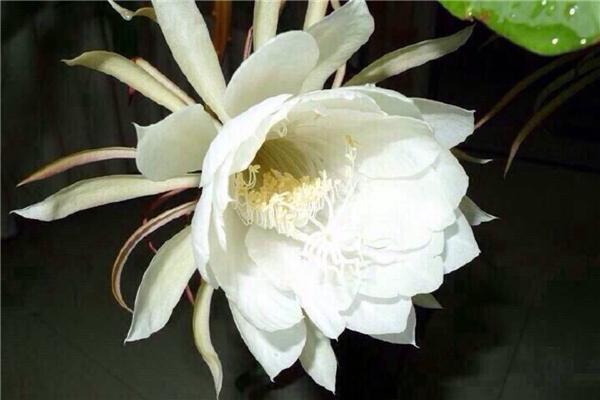
温度
#昙花 比较喜欢在潮湿温暖的环境中生存,一般进入秋季之后,温度最好是在12到18度之间,而且到了深秋之后大约是在10月中旬前后就需要放进室内养护了,以免温度过低影响谈话的生长。
光照
昙花很喜欢在半阴的环境里生长。在秋天的话,就最好是放在室外的半阴的地方养护了,不能受到阳光的直射和暴晒,否则植株有可能就会茎叶变黄,枯萎,影响美观。

土壤
土壤的话要选择腐殖质比较丰富,排水能力比较好,土质疏松的砂质土,最好是微酸性的,避免植株沤根,可以用两份的腐叶土,两份园土和一份砂土配置形成,而且配好之后要在阳光下曝晒杀菌消毒。种的时候先放一些砖片或是碎的瓦片在花盆的下面,使土壤更好的排水。

水分
浇水方面的话最好是让土壤稍微干燥一些,特别是秋末的时候,一般可以等到土壤干燥了之后再浇水,让土壤别过于干燥就好。
施肥
肥料在秋季可以用一些腐熟的液肥,来帮助植株的开花和生长。在秋天可以一个月用一次氮肥,浓度适宜就好。
0
0
成长记
Lucky Coyote
2017年09月07日

mommy Vera has done her job, and now there's 12 babies waiting to get stronger roots before going off to new homes 😙
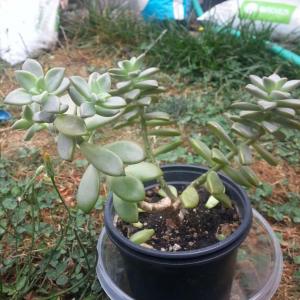
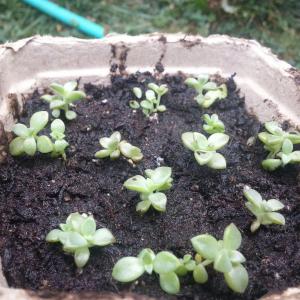


2
0
文章
Dummer. ゛☀
2017年08月30日

Brugmansia is an eye-catching flowering plant native to Central and South Americas. The plant is also known as angel trumpet due to its 10-inch long blooms. Brugmansia angel trumpet is a monster of a plant and can grow up to 12 feet tall. These plants are not winter hardy but can be grown as annuals in northern climates in the summer. Growing brugmansia in ground works well in United States Department of Agriculture zones 9 to 12. Try a brugmansia in the garden for show-stopping color and dynamic proportions.
Brugmansia Angel Trumpet
Brugmansia are a popular collector’s plant. There are seven species of brugmansia but innumerable cultivars. The seven species are listed as extinct in the wild and today these plants are grown as ornamental specimens.
Brugmansia are heavy feeders and require quite a bit of water. Good brugmansia plant care will result in a small tree decorated with dangling trumpet-shaped flowers. Caring for brugmansia outdoors requires warm temperatures and a sunny location with protection from midday sun.
Brugmansia are divided into two groups that are genetically and regionally different. The warm group prefers warmer, sunny locations while the cool group flowers best in cooler temperatures. Both groups produce massive, woody stemmed plants with alternate toothed leaves, up to 12 inches long. The gigantic blooms are pendant and may be white, pink, yellow, orange, green or red with single, double or even triple petals. The flowers are very showy and often bear an attractive scent. Most brugmansia are pollinated by butterflies and they have a host relationship with many species. One brugmansia species is pollinated by a hummingbird.
Planting Brugmansia in Ground
Using brugmansia in the garden setting offers exotic impact with surprising ease of care. Amend the soil with plenty of organic material and loosen to a depth of a foot before installing the plant. Many gardeners prefer to grow the plants in containers so it is easy to move them indoors over winter. Gardeners in southern regions can simply plant them in a prepared garden plot. Some growers swear that brugmansia grow best in shade with only morning sun. They can also handle full sun but they may get wilted and stressed during the hottest point of the day. A better solution might be to choose a partial shade location. The most important consideration once you have chosen the location is good drainage and consistent moisture. Brugmansia angel trumpet is a huge feeder and needs plenty of moisture to sustain the massive amount of plant matter it produces.
Brugmansia Plant Care
Caring for brugmansia outdoors in summer is no trickier than any other plant so long as it gets 3 inches of water per week and a liquid feeding at least once per month. Brugmansia in warm climates will maintain a dormant state in winter but those in northern climates will either die if left outdoors or must be moved inside before cold weather threatens. Use a good commercial potting soil and a pot large enough to contain the root mass. Brugmansia respond well to pruning in spring. Most pruning consists of cutting back the branch tips to a growth node, but the plant can also withstand a hard pruning to within a few inches of the ground.
Brugmansia are prey to the standard sucking insects and some caterpillars and larvae. Use horticultural insecticide soaps to control any unwanted visitors.

Brugmansia Angel Trumpet
Brugmansia are a popular collector’s plant. There are seven species of brugmansia but innumerable cultivars. The seven species are listed as extinct in the wild and today these plants are grown as ornamental specimens.
Brugmansia are heavy feeders and require quite a bit of water. Good brugmansia plant care will result in a small tree decorated with dangling trumpet-shaped flowers. Caring for brugmansia outdoors requires warm temperatures and a sunny location with protection from midday sun.

Brugmansia are divided into two groups that are genetically and regionally different. The warm group prefers warmer, sunny locations while the cool group flowers best in cooler temperatures. Both groups produce massive, woody stemmed plants with alternate toothed leaves, up to 12 inches long. The gigantic blooms are pendant and may be white, pink, yellow, orange, green or red with single, double or even triple petals. The flowers are very showy and often bear an attractive scent. Most brugmansia are pollinated by butterflies and they have a host relationship with many species. One brugmansia species is pollinated by a hummingbird.

Planting Brugmansia in Ground
Using brugmansia in the garden setting offers exotic impact with surprising ease of care. Amend the soil with plenty of organic material and loosen to a depth of a foot before installing the plant. Many gardeners prefer to grow the plants in containers so it is easy to move them indoors over winter. Gardeners in southern regions can simply plant them in a prepared garden plot. Some growers swear that brugmansia grow best in shade with only morning sun. They can also handle full sun but they may get wilted and stressed during the hottest point of the day. A better solution might be to choose a partial shade location. The most important consideration once you have chosen the location is good drainage and consistent moisture. Brugmansia angel trumpet is a huge feeder and needs plenty of moisture to sustain the massive amount of plant matter it produces.

Brugmansia Plant Care
Caring for brugmansia outdoors in summer is no trickier than any other plant so long as it gets 3 inches of water per week and a liquid feeding at least once per month. Brugmansia in warm climates will maintain a dormant state in winter but those in northern climates will either die if left outdoors or must be moved inside before cold weather threatens. Use a good commercial potting soil and a pot large enough to contain the root mass. Brugmansia respond well to pruning in spring. Most pruning consists of cutting back the branch tips to a growth node, but the plant can also withstand a hard pruning to within a few inches of the ground.

Brugmansia are prey to the standard sucking insects and some caterpillars and larvae. Use horticultural insecticide soaps to control any unwanted visitors.
0
0
文章
Dummer. ゛☀
2017年08月26日

Japanese sweet flag (Acorus gramineus) is a striking little aquatic plant that tops out at about 12 inches. The plant may not be statuesque, but the golden-yellow grass provides plenty of bright color in soggy garden spots, along streams or pond edges, in semi-shady woodland gardens – or nearly any area where the plant’s moisture requirements are met. It is a good choice for stabilizing the soil in damp, erosion-prone soil. Read on for more information about Japanese sweet flag.
Arorus Sweet Flag Info
Japanese sweet flag, also known as Calamus, is native to Japan and China. It is a cooperative, slow-spreading plant that attains a width of 2 feet in about five years. Miniature greenish-yellow blooms appear on spikes in spring and early summer, followed by tiny red berries. The grassy leaves emit a sweet, rather spicy aroma when crushed or stepped on. Sweet flag is hardy to USDA plant hardiness zones 6 through 9, although some Acorus sweet flag info indicates the plant is tough enough for zones 5 through 11.
Sweet Flag Care
It doesn’t take much effort when growing sweet flag grass. Sweet flag plants tolerate light shade or full sun, although the plant benefits from afternoon shade in hot climates. However, full sun is best if the soil is extremely boggy. Average soil is fine, but be sure the soil is consistently moist, as sweet flag doesn’t tolerate bone dry soil and may scorch. Similarly, the leaf tips may turn brown in periods of extreme cold.
To grow sweet flag in a pond or other standing water, place the plant in a container and set it in water less than 4 inches deep. Sweet flag plant benefits from division in spring every three or four years. Plant the small divisions in pots and let them mature before transplanting them into their permanent locations. Otherwise, growing sweet flag grass is nearly effortless.

Arorus Sweet Flag Info
Japanese sweet flag, also known as Calamus, is native to Japan and China. It is a cooperative, slow-spreading plant that attains a width of 2 feet in about five years. Miniature greenish-yellow blooms appear on spikes in spring and early summer, followed by tiny red berries. The grassy leaves emit a sweet, rather spicy aroma when crushed or stepped on. Sweet flag is hardy to USDA plant hardiness zones 6 through 9, although some Acorus sweet flag info indicates the plant is tough enough for zones 5 through 11.

Sweet Flag Care
It doesn’t take much effort when growing sweet flag grass. Sweet flag plants tolerate light shade or full sun, although the plant benefits from afternoon shade in hot climates. However, full sun is best if the soil is extremely boggy. Average soil is fine, but be sure the soil is consistently moist, as sweet flag doesn’t tolerate bone dry soil and may scorch. Similarly, the leaf tips may turn brown in periods of extreme cold.

To grow sweet flag in a pond or other standing water, place the plant in a container and set it in water less than 4 inches deep. Sweet flag plant benefits from division in spring every three or four years. Plant the small divisions in pots and let them mature before transplanting them into their permanent locations. Otherwise, growing sweet flag grass is nearly effortless.
0
0
文章
Dummer. ゛☀
2017年08月24日

Can rosemary survive outside over winter? The answer depends on your growing zone, as rosemary plants are unlikely to survive temperatures below 10 to 20 F. (-7 to -12 C.). If you live in USDA plant hardiness zones 7 or below, rosemary will only survive if you bring it indoors before the arrival of freezing temperatures. On the other hand, if your growing zone is at least zone 8, you can grow rosemary outdoors year round with protection during the chilly months. However, there are exceptions, as a few newer rosemary cultivars have been bred to survive temperatures as low as USDA zone 6 with ample winter protection. Ask your local garden center about ‘Arp,’ ‘Athens Blue Spire’ and ‘Madeline Hill.’ Read on to learn about protecting rosemary plants in winter.
How to Protect Rosemary in Winter
Here are some tips for winterizing rosemary plants:
Plant rosemary in a sunny, sheltered location where the plant is protected from harsh winter winds. A warm spot near your house is your best bet. Prune the plant to about 3 inches after the first frost, then bury the plant entirely with soil or compost. Pile 4 to 6 inches of mulch such as pine needles, straw, finely chopped mulch or chopped leaves over the plant. (Be sure to remove about half of the mulch in spring.) Unfortunately, there is no guarantee that your rosemary plant will survive a cold winter, even with protection. However, you can add a bit of extra protection by covering the plant with a frost blanket during cold snaps. Some gardeners surround rosemary plants with cinderblocks before adding mulch. The blocks provide extra insulation and also help hold the mulch in place.

How to Protect Rosemary in Winter
Here are some tips for winterizing rosemary plants:
Plant rosemary in a sunny, sheltered location where the plant is protected from harsh winter winds. A warm spot near your house is your best bet. Prune the plant to about 3 inches after the first frost, then bury the plant entirely with soil or compost. Pile 4 to 6 inches of mulch such as pine needles, straw, finely chopped mulch or chopped leaves over the plant. (Be sure to remove about half of the mulch in spring.) Unfortunately, there is no guarantee that your rosemary plant will survive a cold winter, even with protection. However, you can add a bit of extra protection by covering the plant with a frost blanket during cold snaps. Some gardeners surround rosemary plants with cinderblocks before adding mulch. The blocks provide extra insulation and also help hold the mulch in place.

0
0



